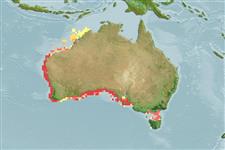Teleostei (teleosts) >
Acropomatiformes (Oceanic basses) >
Pempheridae (Sweepers)
Etymology: Pempheris: Greek, pempheris = the name of a fish (Ref. 45335); ornata: ornata comes from the Latin word ornamentum, meaning ornamented or ornate, in reference to the spectacular coloration of this species compared to its congeners. It is to be treated as Noun in apposition.
Environment: milieu / climate zone / depth range / distribution range
Ecology
Marine; demersal; depth range 9 - 30 m (Ref. 27767). Subtropical
Eastern Indian Ocean: specimen localities are limited to areas along the southwest and south coast of Australia.
Size / Weight / Age
Maturity: Lm ? range ? - ? cm
Max length : 7.5 cm SL male/unsexed; (Ref. 27767)
Reported as sometimes congregating beneath piers and near jetties and not often sighted during the day (Ref. 27767). Minimum depth from Ref. 58018.
Life cycle and mating behavior
Maturity | Reproduction | Spawning | Eggs | Fecundity | Larvae
Mooi, R.D. and R.N. Jubb, 1996. Descriptions of two new species of the genus Pempheris (Pisces: Pempherididae) from Australia, with a provisional key to Australian species. Records of the Australian Museum 48:117-130. (Ref. 27767)
IUCN Red List Status (Ref. 130435: Version 2024-1)
Threat to humans
Harmless
Human uses
Tools
Special reports
Download XML
Internet sources
Estimates based on models
Preferred temperature (Ref.
123201): 16.4 - 18.5, mean 18 °C (based on 20 cells).
Phylogenetic diversity index (Ref.
82804): PD
50 = 0.5000 [Uniqueness, from 0.5 = low to 2.0 = high].
Bayesian length-weight: a=0.01380 (0.00591 - 0.03225), b=3.02 (2.83 - 3.21), in cm total length, based on LWR estimates for this Genus-body shape (Ref.
93245).
Trophic level (Ref.
69278): 3.3 ±0.5 se; based on size and trophs of closest relatives
Resilience (Ref.
120179): High, minimum population doubling time less than 15 months (Preliminary K or Fecundity.).
Fishing Vulnerability (Ref.
59153): Low vulnerability (10 of 100).
Nutrients (Ref.
124155): Calcium = 272 [141, 563] mg/100g; Iron = 1.75 [0.88, 3.16] mg/100g; Protein = 18.2 [17.1, 19.4] %; Omega3 = 0.315 [0.171, 0.570] g/100g; Selenium = 17.6 [8.4, 37.7] μg/100g; VitaminA = 15.2 [4.3, 54.0] μg/100g; Zinc = 1.28 [0.84, 1.94] mg/100g (wet weight);
